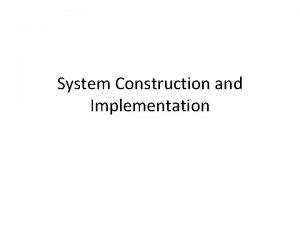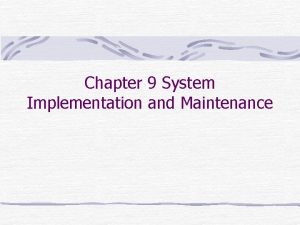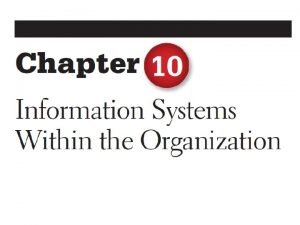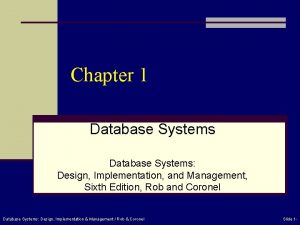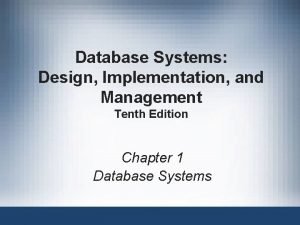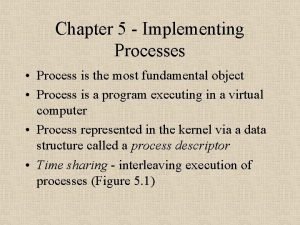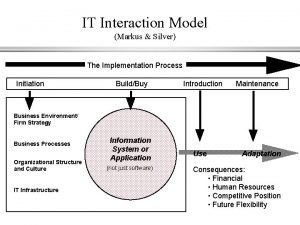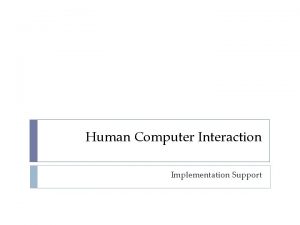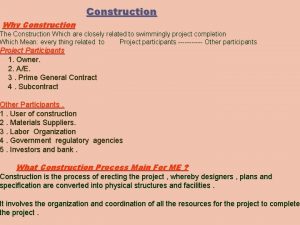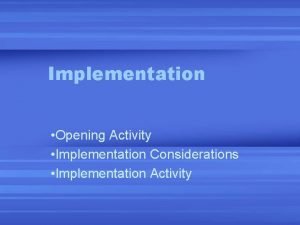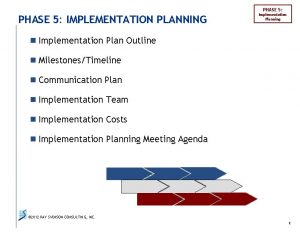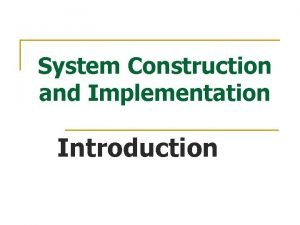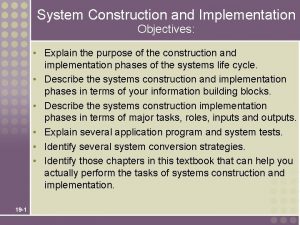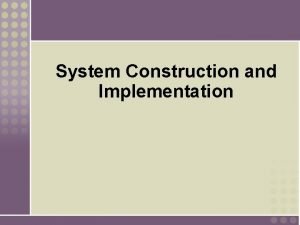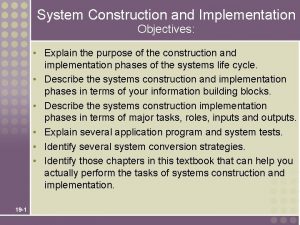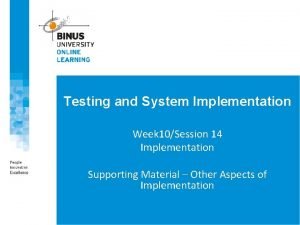System Construction and Implementation What Is System Construction



















- Slides: 19

System Construction and Implementation

What Is System Construction and Implementation? Systems construction – the development, installation, and testing of system components. – A common but unfortunate synonym is systems development (more frequently used to describe the entire life cycle. ) Systems implementation – the installation and delivery of the entire system into production. – Day-to-day operation

The Context of System Construction and Implementation

Tasks for Completing The Construction Phase

Construction Phase – 1. Build and Test Networks • Often system build around existing networks. • If system calls for new network functionality, must by built and tested prior to programs that use that network. • Roles – Network designer • Designs LAN and WAN connectivity – Network administrator builds and tests • Network architecture standards • Security – Systems analyst • Ensures that business requirements are not compromised

Construction Phase – 2. Build and Test Databases • • Implement database schema Test with sample data Deliver unpopulated database structure Roles – System users • Provide and/or approve test data – Database designer/programmer • Build tables, views, stored procedures – Database administrator • “Tune” database for optimum performance • Security • Backup and recovery – Systems Analyst • Build non-corporate, applications-oriented database • Ensures business requirements compliance

Construction Phase – 3. Install and Test New Software • If system requires purchased or leased software, must be installed and tested. • Roles – Systems analyst • Clarifies business requirements – System designer • Clarifies integration requirements • Program documentation to be used in testing the software – Network administrator • Install software package on the network server – Applications programmer • Test according to integration requirements – Software vendor/consultant • Assist in installation and testing

Construction Phase – 4. Write and Test New Programs • Develop in-house programs – – Reuse available software components in library Write new components Test Document • Roles – Systems analyst • Clarifies business requirements – System designer • Clarifies program design and integration requirements – Application programmer (or team) • Writes and tests in-house software

Levels of Testing should not deferred until after the entire program has been written Stub test - a test performed on a subset of a program. – Individual events or modules of a program. – Testing of an isolated subset of a program. Unit or program test – a test performed on an entire program. – All the events and modules tested as an integrated unit. Systems test – a test performed on an entire system – Ensures that application programs written and tested in isolation work properly when integrated into the total system.

Tasks for Completing The Implementation Phase

Implementation Phase - 1. Conduct System Test • Test network, databases, purchased software, new in-house software, and existing software to make sure it all works together. • Roles – Systems analyst • Develops system test data • Communicates problems and issues – System builders (database, network, programmers) • Resolve problems revealed during testing – System owners and users • Verify whether or not system operates correctly • May result in return to construction phase – Iterate until successful system test

Implementation Phase – 2. Prepare Conversion Plan • Plan for how to convert from old system to new system. – How to install and populate databases – How to train users – Finalize documentation – Conversion issues • Roles – System analyst/Project manager • Develop a detailed conversion plan – Steering committee • Approves plan and timetable

Installation Strategies • Abrupt cutover • Parallel conversion • Location conversion Locations • Staged conversion Versions

Systems Acceptance Test Systems acceptance test – a test performed on the final system wherein users conduct a verification, validation, and audit test. – Uses real data over an extended time period – Extensive test that addresses: verification testing, validation testing, and audit testing. Verification testing runs the system in a simulated environment using simulated data. – Alpha testing – Simulated environment using simulated data – Checks for errors and omissions regarding end-use and design specifications

Systems Acceptance Test (continued) Validation testing runs the system in a live environment using real data. – Beta testing – Live environment using real data – Testing: • • • Systems performance (throughput and response time) Peak workload performance Human engineering Methods and procedures Backup and recovery Audit testing certifies that the system is free of errors and is ready to be placed into operation.

Implementation Phase – 3. Install Databases • Populate new system databases with existing data from old system – Generally have to restructure data as it is populated – Must confirm that data is translated correctly • Roles – Application programmers • Write (or use) special programs to extract data from existing databases and populate new databases – Systems analyst/designer • Calculate database sizes and estimate time for installation

Implementation Phase – 4. Train Users • System users trained and provided with documentation • Roles – System analyst • • Plan trainings Conduct trainings Write documentation Help users through the learning period – System owners • Approve release time for training – System users • Attend training • Accept system

An Outline For A Training Manual End-Users Guide Outline I. Introduction II. Manual A. The manual system (a detailed explanation of people’s jobs and standard operating procedures for the new system). B. The computer system (how it fits into the overall workflow). 1. Terminal/keyboard familiarization. 2. First-time end-users. a. Getting started. b. Lessons C. Reference manual (for nonbeginners). III. Appendixes A. Error messages.

Implementation Phase – 5. Convert to New System • Ownership transfers from analysts and builders to end users. • Roles – Systems analyst/Project manager • Carries out conversion plan • Correct shortcomings • Measure system acceptance – System owners • Provide feedback – System users • Provide feedback
 System of construction
System of construction System implementation and maintenance
System implementation and maintenance System design implementation and operation
System design implementation and operation A transaction is any business event that generates
A transaction is any business event that generates Database system design implementation and management
Database system design implementation and management Database systems 10th edition
Database systems 10th edition Implementation of process in operating system
Implementation of process in operating system A deployment descriptor describes *
A deployment descriptor describes * Define the eight stages of the sdlc
Define the eight stages of the sdlc Cse132c
Cse132c Rpc implementation in distributed system
Rpc implementation in distributed system It interaction model in mis
It interaction model in mis Distributed file system notes
Distributed file system notes Oceannodes
Oceannodes State of the art contracting
State of the art contracting Implementation team roles and responsibilities
Implementation team roles and responsibilities Network security design
Network security design Hrd program implementation
Hrd program implementation Implementation tools in hci
Implementation tools in hci Digital marketing: strategy, implementation & practice
Digital marketing: strategy, implementation & practice
